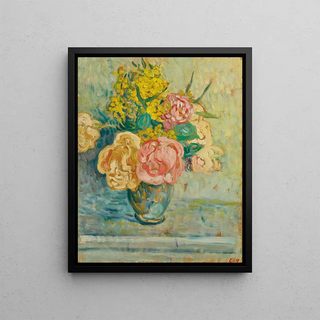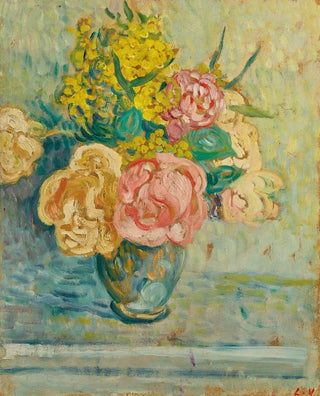Art print | Bouquet of roses and mimosas - Louis Valtat


View from behind

Frame (optional)
In the fascinating world of Impressionist painting, the artwork "Bouquet of roses and mimosa" by Louis Valtat stands out for its delicacy and chromatic richness. This painting, a true ode to nature, invites the viewer to immerse themselves in a world where floral beauty is expressed with brilliance and lightness. The roses, with their radiance and softness, blend harmoniously with the mimosas, adding a touch of warmth and luminosity. Through this piece, Valtat manages to capture the very essence of life, a suspended moment where nature reveals itself in all its splendor.
Style and uniqueness of the artwork
Valtat's style is characterized by bold technique and a vibrant palette. In "Bouquet of roses and mimosa," the brushstrokes are both precise and fluid, creating a movement that seems to animate the flowers. The roses, with their delicate petals, are rendered with such finesse that they almost feel tangible. The mimosas, meanwhile, bring an airy lightness, with their small golden flowers illuminating the painting. This work is distinguished by its almost tactile approach, where each color and shape complement each other to offer a harmonious composition. The artist uses light masterfully, playing with shadows and reflections to bring life to his bouquet. This painting transcends simple floral representation to become a true celebration of the fleeting beauty of nature.
The artist and his influence
Louis Valtat, an emblematic figure of French Impressionism, knew how to establish himself through his originality and unique artistic vision. Influenced by the great masters of his time, he developed a style that is entirely his own, blending tradition and innovation. Valtat explored themes of nature and daily life with particular sensitivity, making his works testimonies of an era where art sought to capture the fleeting moment. His influence extends beyond his own work, inspiring many artists who followed in his footsteps. By incorporating elements of modern life into his compositions, he paved the way for a new approach

Matte finish

View from behind

Frame (optional)
In the fascinating world of Impressionist painting, the artwork "Bouquet of roses and mimosa" by Louis Valtat stands out for its delicacy and chromatic richness. This painting, a true ode to nature, invites the viewer to immerse themselves in a world where floral beauty is expressed with brilliance and lightness. The roses, with their radiance and softness, blend harmoniously with the mimosas, adding a touch of warmth and luminosity. Through this piece, Valtat manages to capture the very essence of life, a suspended moment where nature reveals itself in all its splendor.
Style and uniqueness of the artwork
Valtat's style is characterized by bold technique and a vibrant palette. In "Bouquet of roses and mimosa," the brushstrokes are both precise and fluid, creating a movement that seems to animate the flowers. The roses, with their delicate petals, are rendered with such finesse that they almost feel tangible. The mimosas, meanwhile, bring an airy lightness, with their small golden flowers illuminating the painting. This work is distinguished by its almost tactile approach, where each color and shape complement each other to offer a harmonious composition. The artist uses light masterfully, playing with shadows and reflections to bring life to his bouquet. This painting transcends simple floral representation to become a true celebration of the fleeting beauty of nature.
The artist and his influence
Louis Valtat, an emblematic figure of French Impressionism, knew how to establish himself through his originality and unique artistic vision. Influenced by the great masters of his time, he developed a style that is entirely his own, blending tradition and innovation. Valtat explored themes of nature and daily life with particular sensitivity, making his works testimonies of an era where art sought to capture the fleeting moment. His influence extends beyond his own work, inspiring many artists who followed in his footsteps. By incorporating elements of modern life into his compositions, he paved the way for a new approach






